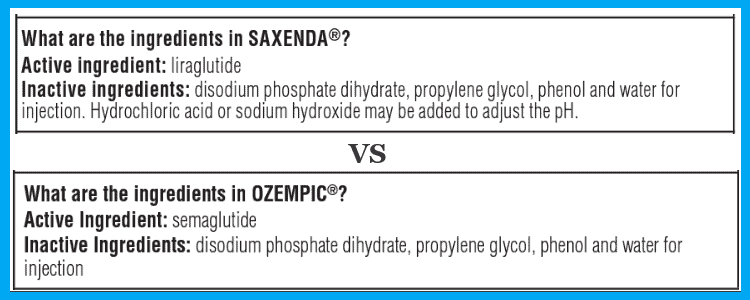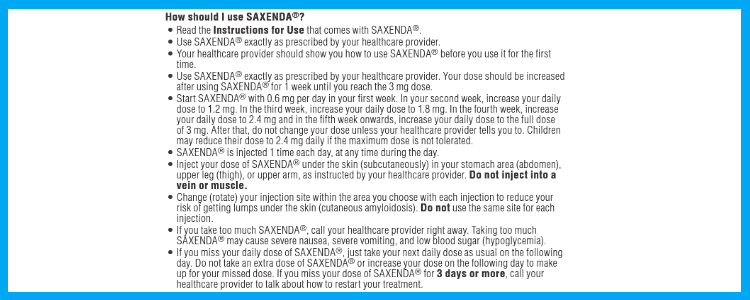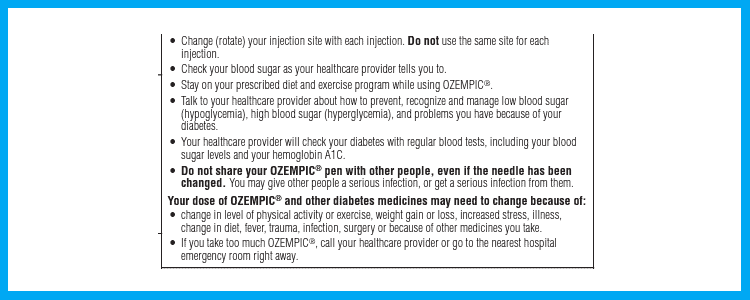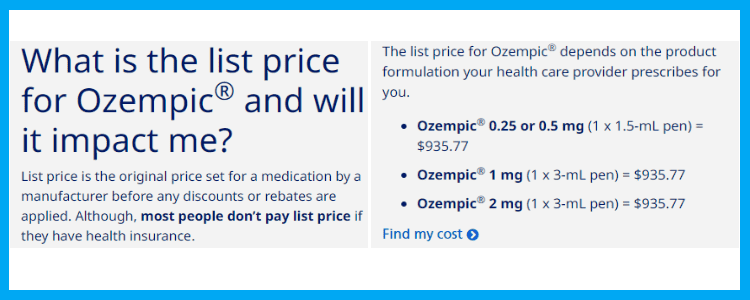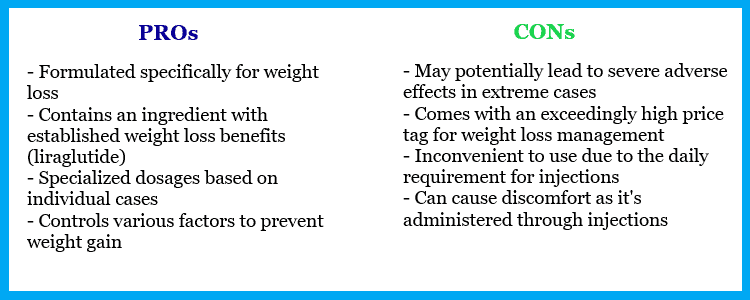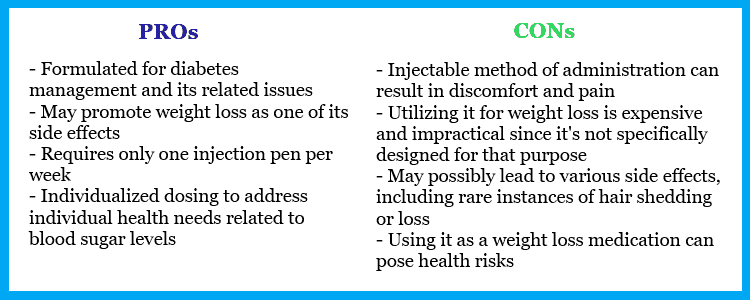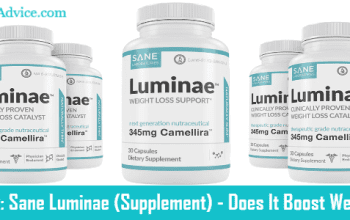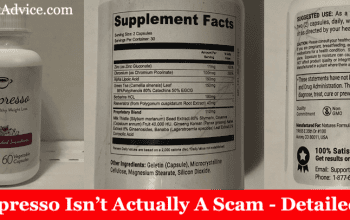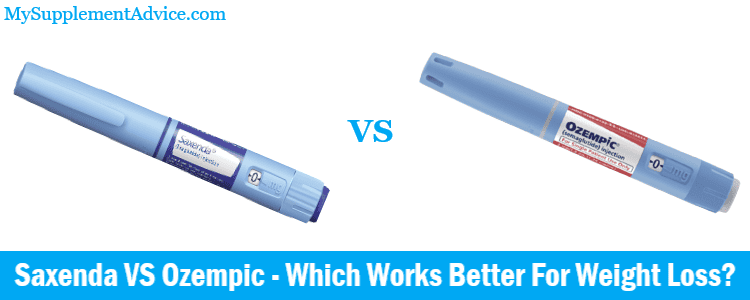
It's time to conduct a comparative review of Saxenda VS Ozempic.
I'm pretty sure you already heard that these products are associated with weight loss.
Yet, what are the points that distinguish them?:
- Which one has a more specialized formula for weight loss?
- Is there a significant price difference between them?
- Which has better weight loss results?
Let's talk more about the important features of each product below, so that we can answer these questions.
Note: This review is based on my experience + research on these 2 products.
Saxenda VS Ozempic (In A Nutshell)
If we were to compare Saxenda VS Ozempic in terms of weight loss, which would be better?
Shortly, Saxenda is clearly above Ozempic, due to several practical reasons:
- Saxenda's formula is specifically designed to support weight loss
- it offers a precise dose of liraglutide
- the price is notably lower than Ozempic's
In this review, our focus is on which product is more effective for people dealing with obesity.
Since it's a prescription drug for people with diabetes, Ozempic is clearly not the winner.
Some of its users have indeed experienced weight loss as a side effect…
But that wasn't really its primary purpose.
The only area where Ozempic is better is its flexible use.
It only requires one weekly injection, while Saxenda has to be injected every day.
Now, if I had to choose between them, I would opt for Saxenda.
That's because it's specifically formulated as a weight loss treatment.
But if you ask me, both medications have risky side effects.
So it's better to consult your doctor first.
Additionally, both are very pricey so it's not practical to buy them (unless you really need them).
If you don't have diabetes or obesity-related problems, I suggest you to look for other weight loss alternatives.
In my view, PhenQ is the best option for a safe and effective weight loss.
It has a lot of testimonials about its weight loss results, so its potential is real.
Furthermore, it's budget-friendly and it's really safe for everyone to try.
#1 – Ingredients – WINNER: Saxenda
To begin with, let's discuss the formulations of Saxenda and Ozempic:
- their top active compounds
- how they promote weight loss
Actually – the two products are FDA-approved already.
But if we're talking about real weight management, there's an obvious winner.
Well – it's Saxenda, since it's formula is created for weight loss.
Meanwhile, Ozempic is a prescription medication for type 2 diabetes whose secondary effect may be losing weight.
With that in mind, we're going to talk more about their ingredients below.
1. Saxenda's Ingredients
Firstly – liraglutide is the key compound of Saxenda (3 mg).
It works as a GLP-1 receptor agonist with the following benefits:
- normalizes blood glucose, blood pressure and triglyceride levels
- enhances insulin sensitivity and function of pancreatic cells [1]
- promotes weight loss [2]
- mitigates complications linked to obesity, particularly type 2 diabetes [3]
In my previous review of Saxenda, I mentioned that it offers several advantages:
- suppressed appetite
- delayed emptying of gastric acid
- loss of excess body weight
- an extended sensation of fullness
Now – liraglutide influences neuronal pathways [4].
To be more exact, it influences how the neurotransmitters condition your body to target excess weight.
So further research was done to observe its positive effects on our brains.
Some of the results indicate that liraglutide exhibits antidepressant properties [5].
With that – it shouldn't pose harm to our health.
However, similar to WeGovy, there have been negative reports about Saxenda.
To be exact – it was associated with suicidal thoughts and depression (in rare instances, though).
If you ask me, I don't recommend Saxenda if you have experienced past mental health issues.
Although those problems won't appear in most cases, the possibility is there.
Sure – it's a prescription drug proven to help you lose weight, but it's still risky.
2. Ozempic‘s Ingredients
On the other hand, Ozempic has a different composition.
Its main active compound is semaglutide:
- promotes increased insulin production by the pancreas during periods of elevated blood sugar
- reduces the risk of heart attack, stroke, or mortality [6]
- decreases A1C levels (average blood sugar levels) [7]
- lowers the likelihood of major heart-related issues in individuals with cardiovascular conditions
- encourages weight loss in people suffering from diabetes
Also – it has varying doses depending on the needs of a person suffering from diabetes (0.5, 1 or 2 mg).
You might be wondering why Ozempic is not marketed for weight loss (even though some people use it as such).
Also – you might compare it to WeGovy, since both have the same ingredient (semaglutide).
Well, the key distinction is the dose of that compound.
So the weight reduction caused by Ozempic is just a secondary outcome.
Therefore, using the product solely for the purpose of weight loss (especially if you don't have diabetes) is risky.
Additionally – discontinuing the administration can lead to weight gain right away [8].
So if you ask me, it's not really worth it.
Besides, Ozempic is specifically formulated to aid diabetes (not obesity).
In addition – some people suffered from hair thinning/loss when they used the product.
Thus, it's not really advisable to use Ozempic unless you have diabetes.
Not to mention that it also contains semaglutide, which influences neurotransmitters.
So just like Saxenda, it's best to consult your doctor first.
Conclusion
Overall – these products are 2 completely different medications.
Ozempic is primarily made to manage diabetes, while Saxenda is formulated to help obese people lose weight.
So with that, it's pretty obvious that Saxenda is the winner in this category.
#2 – Consistency & Dosage – WINNER: Ozempic
Now – let's focus on the physical attributes of Saxenda and Ozempic in this section:
- usage instructions
- how to take them correctly
In my view, Ozempic is clearly the winner, since its usage frequency is more forgiving.
But let me explain below the directions of use for each product.
1. Saxenda
To start off, here's a brief description of Saxenda's characteristics:
- clear watery liquid
- medicinal-like smell
To enlighten you, Saxenda is available in a pre-filled injection format.
So you don't have to measure the precise dosage yourself.
However – its primary drawback is that you're required to do daily injections.
If you ask me, this is extremely painful and uncomfortable.
So doing this every day is absolutely terrible.
Moreover, self-administration takes a lot of focus and time.
2. Ozempic
Honestly – Ozempic's appearance is not very far from Saxenda:
- colorless and flowy texture
- subtle hint of medicinal scent
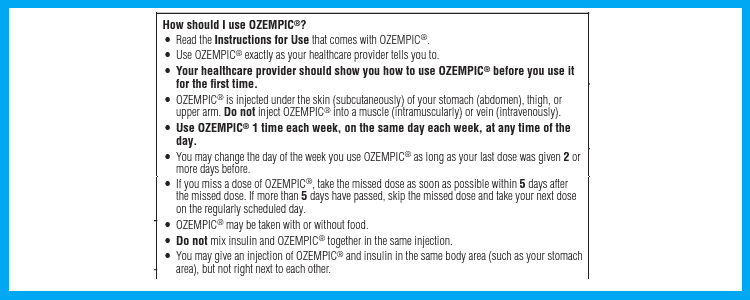
Similar to Saxenda, Ozempic also comes as an injection (pre-filled).
With that, all you need to do is simply administer it subcutaneously.
The edge of this product is that you only need to use it once a week.
But if you ask me, it's still not the most comfortable medication, especially if you compare it to other alternatives.
Conclusion
In my view, Saxenda and Ozempic are both challenging to use.
But if we're only going to compare their frequency of use, Ozempic is more advantageous.
Again – it only requires one injection pen every week.
So that's the only reason why it won in this chapter.
#3 – Results – WINNER: Saxenda
For the next part, we're going to look at the customer feedback for Saxenda and Ozempic.
Our main focus will be their weight loss results, obviously.
Note: I only analyzed authentic reviews, not promotional or fake ones.
1. Saxenda
Being a prescription medication, there aren't lot of user reviews for Saxenda.
But let me outline the comments I found from various credible sources:
- Some users achieved a normal BMI through consistent use of the product.
- Others noted a reduction in their appetite and cravings.
- A substantial number of individuals who used Saxenda mentioned a notable weight loss.
- In rare cases, some people reported an increase in body weight.
- There were also users who encountered adverse reactions.
Saxenda can indeed contribute to weight reduction, especially for people with real health issues.
Well – that's really expected since it's formulated with a clear goal in mind.
So it can harm your health if you use it without having a specific medical condition.
Now – if you're only trying to shed excess weight, just look for other options.
2. Ozempic
Firstly – it's important to remember that Ozempic is primarily intended for people with type 2 diabetes.
So expect a different user feedback:
- Users said that it helped them control their cravings and appetite.
- Diabetic individuals mentioned that their blood sugar levels normalized.
- Others observed a gradual reduction of their excess weight.
- Some of them did not see the same level of results in their blood sugar or weight.
- The rest complained about the adverse reactions they experienced.
As I said, Ozempic is effective for diabetes management, especially for controlling blood sugar levels.
Just make sure that you don't use it randomly.
However, I don't recommend that you choose it solely for weight loss purposes.
Again – it's intended for diabetes. Weight loss is just its secondary effect.
So there's a high chance that you're putting your health at risk.
Conclusion
To summarize, Saxenda is better than Ozempic in terms of weight loss.
That's because it's a prescription medication designed for obesity and its related issues.
Overall – both products require a doctor's prescription, so you shouldn't use them on your own.
But if you ask me, you can still find alternatives that are effective and less risky.
#4 – Side Effects – DRAW
In this chapter, let's discuss the possible adverse reactions of both products.
Also – we're going to compare if they have any similarities or not.
1. Saxenda

- occurrences of depression or suicidal thoughts
- inflammation of the pancreas
- gallstone formation or kidney problems
- abnormal or rapid heart rate
- allergic reactions to the medication
- hypoglycemia
- swelling at the injection sites
- nausea, vomiting, or fatigue
- digestive issues like constipation, diarrhea, or stomachache
In my view, the issues above have some similarities to the adverse reactions associated with WeGovy.
Although they have different active ingredients, the nature of those compounds is the same (GLP-1 receptor agonist).
So keep in mind that not everyone is eligible to use Saxenda.
Again – it's prescribed for individuals with specific health conditions especially overweight-related issues.
Moreover, it's important to avoid using Saxenda concurrently with other GLP-1 receptor agonist medications.
That's to avoid the possible interactions that can harm your health.
Lastly – liraglutide's mechanism of action involves neuronal pathways.
So it's advisable to exercise caution when considering Saxenda if you have mental health problems.
Sure – the direct connection between these factors is not yet fully established.
But I still urge you to be careful with the product and not use it unless your doctor authorizes you to.
2. Ozempic
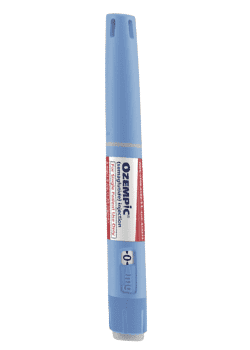
Using it without proper consultation with a doctor can be risky and may lead to various reactions:
- potential hair loss or thinning
- redness or skin rashes at the injection site
- possible increased risk of thyroid cancer
- damage or failure of kidney functions
- pancreatic problems
- abnormally low blood sugar levels
- vision problems or diabetic retinopathy
- vomiting and headache
- irritability and/or nausea
- bloating, diarrhea or digestive discomfort
While some of these effects may appear similar to those associated with Saxenda, there are still differences.
Again – weight loss is just a secondary effect of Ozempic
Although it may sound promising, it still comes with certain risks.
The major one is the Ozempic's potential to cause hair problems.
To give you an idea, rapid weight loss may lead to temporary hair shedding in a very small portion of individuals.
This condition is known as telogen effluvium [9].
With this in mind, I strongly advise against using Ozempic if you're not diagnosed with diabetes.
But for those who suffer from the said condition, it really depends on you if you'll take a risk or not.
Conclusion
All in all, Saxenda and Ozempic come with potential side effects (just like any medicine).
In my view, they have a similar level of risk in addressing their intended health concerns.
Therefore – it's really important to be cautious if you want to consider using either product.
But honestly, you can avoid those risks by looking for safer weight loss alternatives.
#5 – Price – WINNER: Saxenda
In the last category, we will assess and compare the pricing of Saxenda and Ozempic.
To be honest, both medications come with very high price tags.
So let me provide more info below to help you assess the products if they are worth it or not.
Note: I will only analyze the price of the 2 products.
1. Saxenda
As we already know, you need a prescription before you can purchase Saxenda.
So let me give a list of the details below just in case you want to know more:
- A 30-day supply costs around $1,349.02
- You may qualify for discounts if you have insurance coverage
So if you do the math, one injection pen has an estimated price of $45.
Of course, it might appear to be forgiving given that it's effective for a lot of people.
However – it's important to remember that Saxenda requires daily use.
If you ask me, spending $45 a day is actually expensive in reality.
Honestly – I still think that there are other more affordable yet equally effective weight loss regimens out there.
With that, I don't particularly recommend that you invest in Saxenda if you don't really need it.
2. Ozempic
Now – the price tag of Ozempic is way higher than Saxenda:
- A single pen is priced around $935.77 (regardless of the dose and quantity of semaglutide)
- Health insurance coverage may lessen the cost (depending on the specific insurance plan)
As previously mentioned, Ozempic requires a once-a-week injection schedule.
Therefore, the monthly cost would amount to $3,743.08 since you need 4 injection pens.
If you think about it, that's basically nearly three times Saxenda's actual price.
In my view, Ozempic is not a cost-effective choice if the sole purpose of considering it is to shed excess weight.
Again – its main purpose is diabetes management.
Using it for other intentions will just waste your money and risk your health.
Conclusion
Overall – it's pretty obvious that Saxenda's pricing is much lower than that of Ozempic.
However, I don't recommend it for weight loss since there are more budget-friendly and effective options out there.
Furthermore, comparing the prices of Saxenda and Ozempic may not be that relevant (in my view).
Again – they are different products designed for separate medical purposes.
But still, in terms of losing excess weight, I urge you to invest more in products with a better quality-to-price ratio.
#6 – Pros & Cons
Lastly – let's look at the summary of the pros and cons of both Saxenda and Ozempic.
The purpose of this is to help you determine their suitability for weight loss.
1. Saxenda
2. Ozempic
My Verdict – Saxenda Or Ozempic?
Short answer: Saxenda – simply because it's a prescription medicine designed to reduce excess weight.
With that, here are the reasons why it has more advantages:
- actual price is lower (compared to Ozempic)
- formula's specific purpose is for weight loss
- liraglutide's dose is decent enough to manage obesity and its related issues
Once again, Ozempic is primarily prescribed for individuals dealing with diabetes.
While it may lead to weight reduction in some users, it's not a weight loss treatment.
That's Saxenda is better for overweight or obese people than Ozempic.
Now – if you're healthy and want to lose some weight, Saxenda and Ozempic are very pricey options.
Additionally, you should known that both products pose dangers when used incorrectly.
With that, I strongly suggest that you find a safer, more affordable and high-quality alternative.
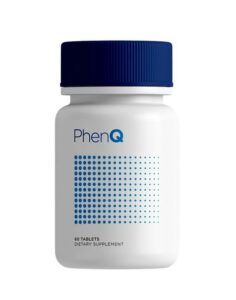
- Comes with highly potent ingredients that promote weight reduction
- Clinically proven to decrease excessive body weight
- Provides five distinct mechanisms to control cravings and prevent weight gain
- It's a more budget-friendly solution for weight loss
- Convenient and safe to include in daily routine
You might have reservations about PhenQ's potency to reduce excess weight.
Simply because it's a supplement and not a prescription medicine.
But to tell you, it's a better option for weight loss due to its promising features.
Plus, it's less risky and has impressive results backed by satisfied users.
And what's the best part if you ask me?
PhenQ is affordable with a starting price of $69, which can go at $37 for a month's supply.
In my view, it's the smart and practical choice if you aim to lose weight, control weight gain, and curb your appetite.
Also – its excellent qualities guarantee value for your money.
So for what it can offer, it's still my top recommendation for weight loss supplements.
References:
1 – https://www.elsevier.es/-effects-liraglutide/
2 – https://www.ncbi.nlm.nih.gov/pmc/articles/-PMC3781545/
3 – https://pubmed.ncbi.nlm.nih.gov/-23360033/
4 – https://www.ncbi.nlm.nih.gov/pmc/articles/-PMC4478577/
5 – https://pubmed.ncbi.nlm.nih.gov/-36566932/
6 – https://www.ncbi.nlm.nih.gov/pmc/articles/-PMC7526237/
7 – https://www.ncbi.nlm.nih.gov/pmc/articles/-PMC7193006/
8 – https://health.ucdavis.edu/blog/cultivating-health/-ozempic/
9 – https://www.ncbi.nlm.nih.gov/pmc/articles/-PMC5315033/


